Epidemic Waves in a Stochastic SIRVI Epidemic Model Incorporating the Ornstein–Uhlenbeck Process
Abstract
1. Introduction
2. Existence of the Unique Global Positive Solution
3. Driving Transmission Rate from the Infected Population for the Deterministic SIRVI Model and Numerical Solution
4. Numerical Simulations
5. Conclusions
- We proved the existence and uniqueness of a global solution to a stochastic SIRVI epidemic model incorporating the Ornstein–Uhlenbeck process, and we developed a suitable Lyapunov function to obtain sufficient conditions for persistence in the mean and exponential extinction of infectious disease;
- The transmission rate is perturbed by the Ornstein–Uhlenbeck process and is numerically solved by using several speed-of-reversion and volatility values. This was compared with the solutions of (23)–(24), and we found that there is no real relationship between the two transmission rates;
- After using an exponential smoothing technique, we concluded that the transmission rate obtained from the perturbed (from the Ornstein–Uhlenbeck process) system could be represented by a finite linear combination of the Gaussian radial basis function;
- The numerical solutions of the stochastic SIRVI epidemic model incorporating the Ornstein–Uhlenbeck process, where the transmission rate is smoothed by using an exponential smoothing technique, predict epidemic waves accurately;
- The selection of Saudi Arabia and Austria was random, and the method we provided in this paper can be applied to any confirmed daily active cases from any other countries;
- The theory we developed here can also be used to study any epidemic compartmental models;
- There are many other parameters involved in epidemic modeling, which are also functions of time. These parameters, such as mortality rate, will be the subject (on the basis of our result) of future research.
Author Contributions
Funding
Data Availability Statement
Acknowledgments
Conflicts of Interest
References
- Roberts, M.G.; Heesterbeek, J.A.P. Mathematical models in epidemiology. Math. Model. 2003, 49, 6221. [Google Scholar]
- Siettos, C.I.; Russo, L. Mathematical modeling of infectious disease dynamics. Virulence 2013, 4, 295–306. [Google Scholar] [CrossRef] [PubMed]
- Krämer, A.; Kretzschmar, M.; Krickeberg, K. (Eds.) Modern Infectious Disease Epidemiology: Concepts, Methods, Mathematical Models, and Public Health; Springer: Berlin/Heidelberg, Germany, 2009; pp. 209–221. [Google Scholar]
- Brauer, F. Mathematical epidemiology: Past, present, and future. Infect. Dis. Model. 2017, 2, 113–127. [Google Scholar] [CrossRef] [PubMed]
- Kermack, W.O.; McKendrick, A.G. Contributions to the mathematical theory of epidemics I. Bull. Math. Biol. 1991, 53, 33–55. [Google Scholar] [PubMed]
- Kermack, W.O.; McKendrick, A.G. Contributions to the mathematical theory of epidemics II. The problem of endemicity. Bull. Math. Biol. 1991, 53, 57–87. [Google Scholar] [PubMed]
- Kermack, W.O.; McKendrick, A.G. Contributions to the mathematical theory of epidemics III. Further studies of the problem of endemicity. Bull. Math. Biol. 1991, 53, 89–118. [Google Scholar]
- Hethcote, H.W. The Mathematics of Infectious Diseases. SIAM Rev. 2000, 42, 599–653. [Google Scholar] [CrossRef]
- Pollard, A.J.; Bijker, E.M. A guide to vaccinology: From basic principles to new developments. Nat. Rev. Immunol. 2020, 21, 83–100. [Google Scholar] [CrossRef]
- Rifhat, R.; Teng, Z.; Wang, C. Extinction and persistence of a stochastic SIRV epidemic model with nonlinear incidence rate. Adv. Differ. Equ. 2021, 2021, 200. [Google Scholar] [CrossRef]
- Oke, M.O.; Ogunmiloro, O.M.; Akinwumi, C.T.; Raji, R.A. Mathematical Modeling and Stability Analysis of a SIRV Epidemic Model with Non-linear Force of Infection and Treatment. Commun. Math. Appl. 2019, 10, 717–731. [Google Scholar] [CrossRef]
- Ishikawa, M. Optimal strategies for vaccination using the stochastic SIRV model. Trans. Inst. Syst. Control Inf. Eng. 2012, 25, 343–348. [Google Scholar] [CrossRef][Green Version]
- Meng, X.; Cai, Z.; Dui, H.; Cao, H. Vaccination strategy analysis with SIRV epidemic model based on scale-free Networks with tunable clustering. IOP Conf. Ser. Mater. Sci. Eng. 2021, 1043, 032012. [Google Scholar] [CrossRef]
- Farooq, J.; Bazaz, M.A. A novel adaptive deep learning model of COVİD-19 with focus on mortality reduction strategies. Chaos Solitons Fractals 2020, 138, 110148. [Google Scholar] [CrossRef]
- Omae, Y.; Kakimoto, Y.; Sasaki, M.; Toyotani, J.; Hara, K.; Gon, Y.; Takahashi, H. SIRVVD model-based verification of the effect of first and second doses of COVID-19/SARS-CoV-2 vaccination in Japan. Math. Biosci. Eng. 2021, 19, 1026–1040. [Google Scholar] [CrossRef] [PubMed]
- Lu, R.; Wei, F. Persistence and extinction for an age-structured stochastic SVIR epidemic model with generalized nonlinear incidence rate. Phys. A Stat. Mech. Its Appl. 2018, 513, 572–587. [Google Scholar] [CrossRef]
- Yang, J.; Martcheva, M.; Wang, L. Global threshold dynamics of an SIVS model with waning vaccine-induced immunity and nonlinear incidence. Math. Biosci. 2015, 268, 1–8. [Google Scholar] [CrossRef]
- Wen, B.; Teng, Z.; Li, Z. The threshold of a periodic stochastic SIVS epidemic model with nonlinear incidence. Phys. A Stat. Mech. Its Appl. 2018, 508, 532–549. [Google Scholar] [CrossRef]
- Turkyilmazoglu, M. An extended epidemic model with vaccination: Weak-immune SIRVI. Phys. A Stat. Mech. Its Appl. 2022, 598, 127429. [Google Scholar] [CrossRef]
- Shi, Z.; Zhang, X.; Jiang, D. Dynamics of an avian influenza model with half-saturated incidence. Appl. Math. Comput. 2019, 355, 399–416. [Google Scholar] [CrossRef]
- Dai, Y.; Zhou, B.; Jiang, D.; Hayat, T. Stationary distribution and density function analysis of stochastic susceptible-vaccinated-infected-recovered (SVIR) epidemic model with vaccination of newborns. Math. Methods Appl. Sci. 2022, 45, 10991476. [Google Scholar] [CrossRef]
- Chang, Z.; Meng, X.; Hayat, T.; Hobiny, A. Modeling and analysis of SIR epidemic dynamics in immunization and cross-infection environments: Insights from a stochastic model. Nonlinear Anal. Model. Control 2022, 27, 740–765. [Google Scholar] [CrossRef]
- Lan, G.; Yuan, S.; Song, B. The impact of hospital resources and environmental perturbations to the dynamics of SIRS model. J. Frankl. Inst. 2021, 358, 2405–2433. [Google Scholar] [CrossRef]
- Qi, H.; Meng, X. Mathematical modeling, analysis and numerical simulation of HIV: The influence of stochastic environmental fluctuations on dynamics. Math. Comput. Simul. 2021, 187, 700–719. [Google Scholar] [CrossRef]
- Allen, E. Environmental variability and mean-reverting processes. Discret. Contin. Dyn. Syst. Ser. B 2016, 21, 2073–2089. [Google Scholar] [CrossRef]
- Song, Y.; Zhang, X. Stationary distribution and extinction of a stochastic SVEIS epidemic model incorporating Ornstein–Uhlenbeck process. Appl. Math. Lett. 2022, 133, 108284. [Google Scholar] [CrossRef]
- Shi, Z.; Jiang, D. Dynamics and density function of a stochastic differential infectivity epidemic model with Ornstein–Uhlenbeck process. Math. Methods Appl. Sci. 2022, 46, 6245–6261. [Google Scholar] [CrossRef]
- Khasminskii, R. Stochastic Stability of Differential Equations; Springer: Berlin, Germany, 2012. [Google Scholar] [CrossRef]
- Alshammari, F.S.; Tezcan, E.A. Exploring radial kernel on the novel forced SEYNHRV-S model to capture the second wave of COVID-19 spread and the variable transmission rate. Mathematics 2022, 10, 1501. [Google Scholar] [CrossRef]
- Chen, Y.-C.; Lu, P.-E.; Chang, C.-S.; Liu, T.-H. A time-dependent sır model for COVID-19 with undetectable ınfected persons. IEEE Trans. Netw. Sci. Eng. 2020, 7, 3279–3294. [Google Scholar] [CrossRef]
- Milstein, G.N. Numerical İntegration of Stochastic Differential Equations, Volume 313 of Mathematics and İts Applications; Translated and Revised from the 1988 Russian Original; Kluwer Academic Publishers Group: Dordrecht, The Netherlands, 1995. [Google Scholar]

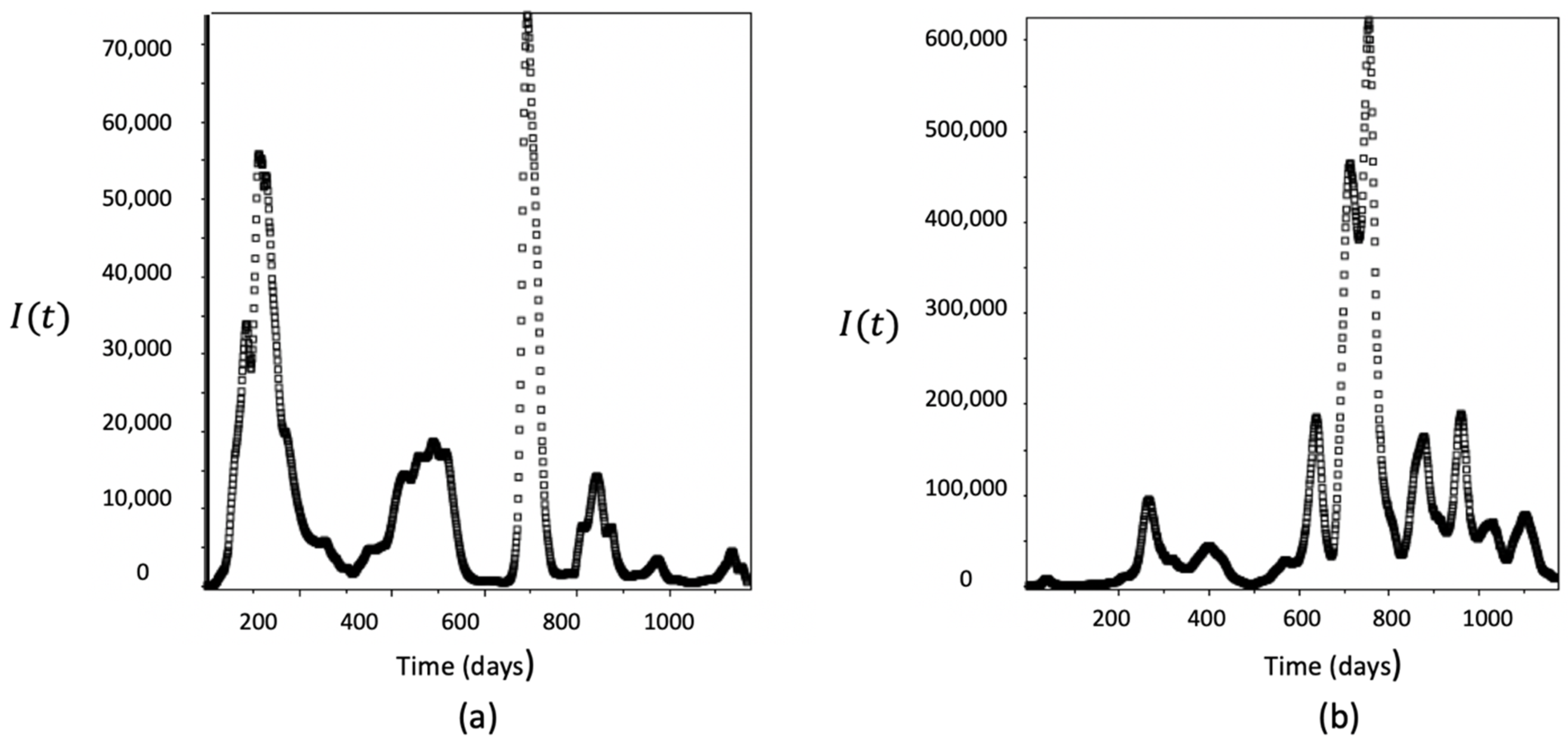
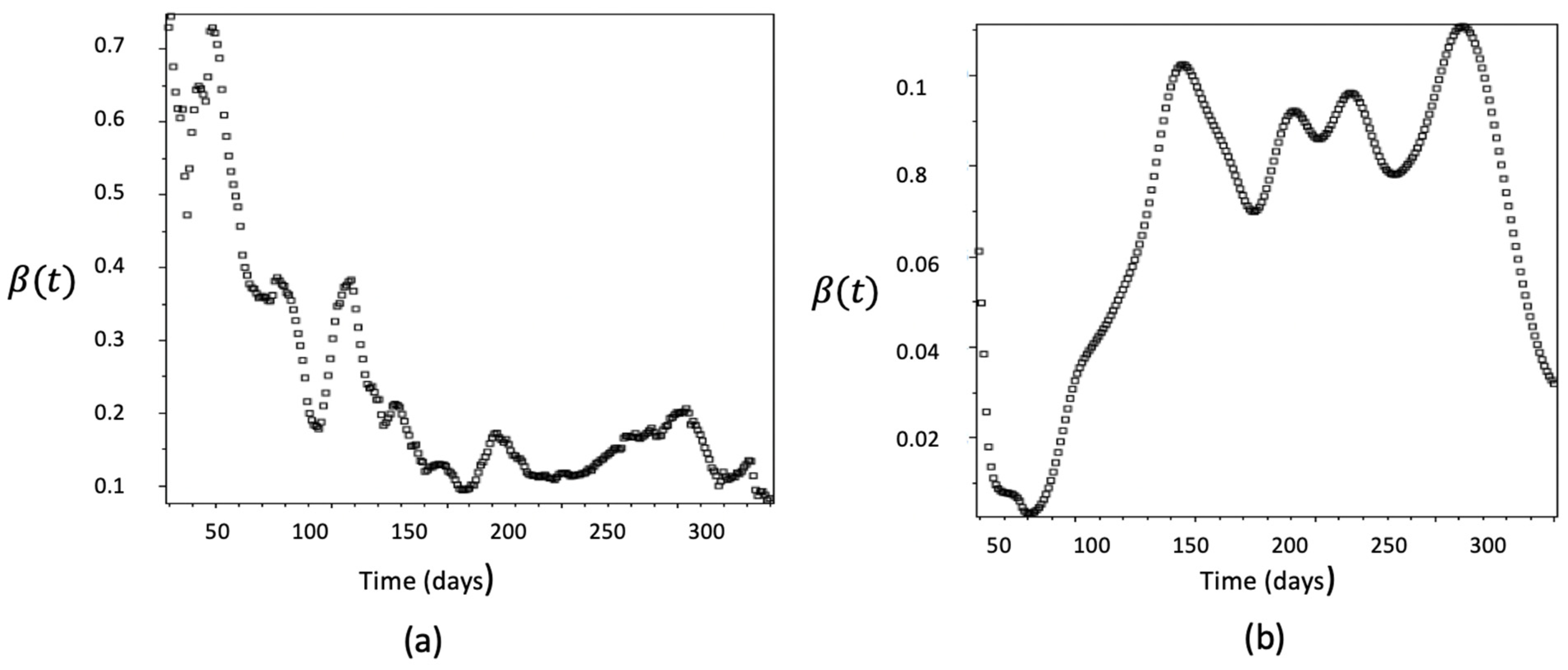

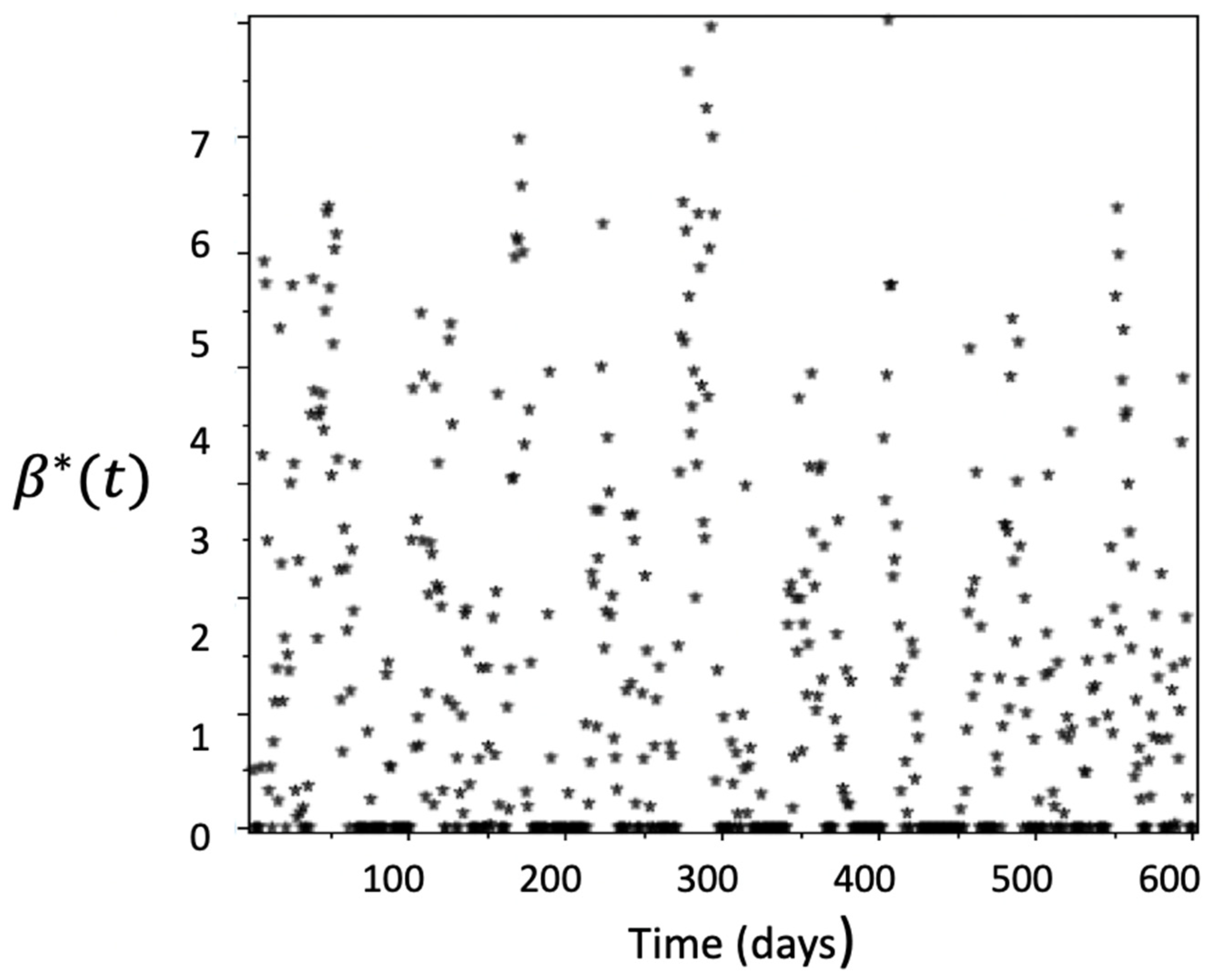


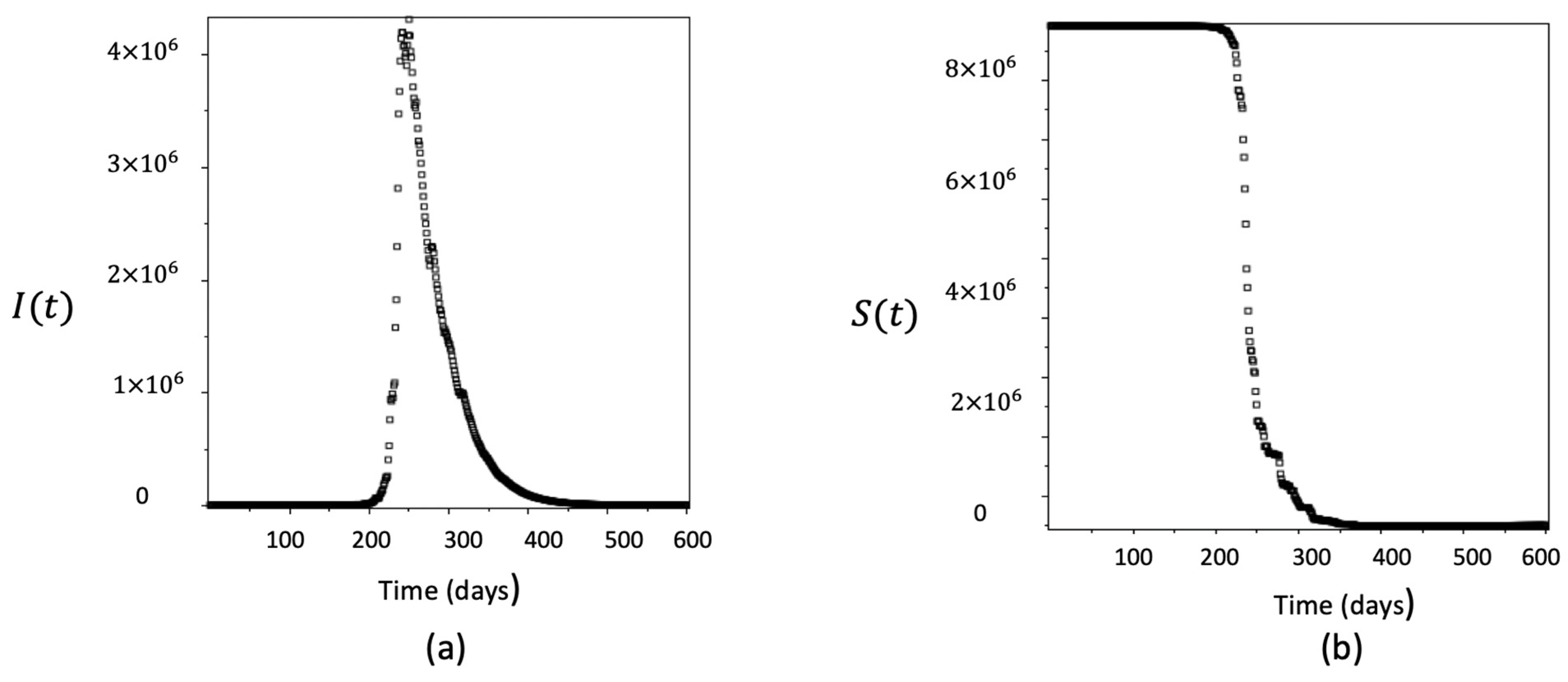
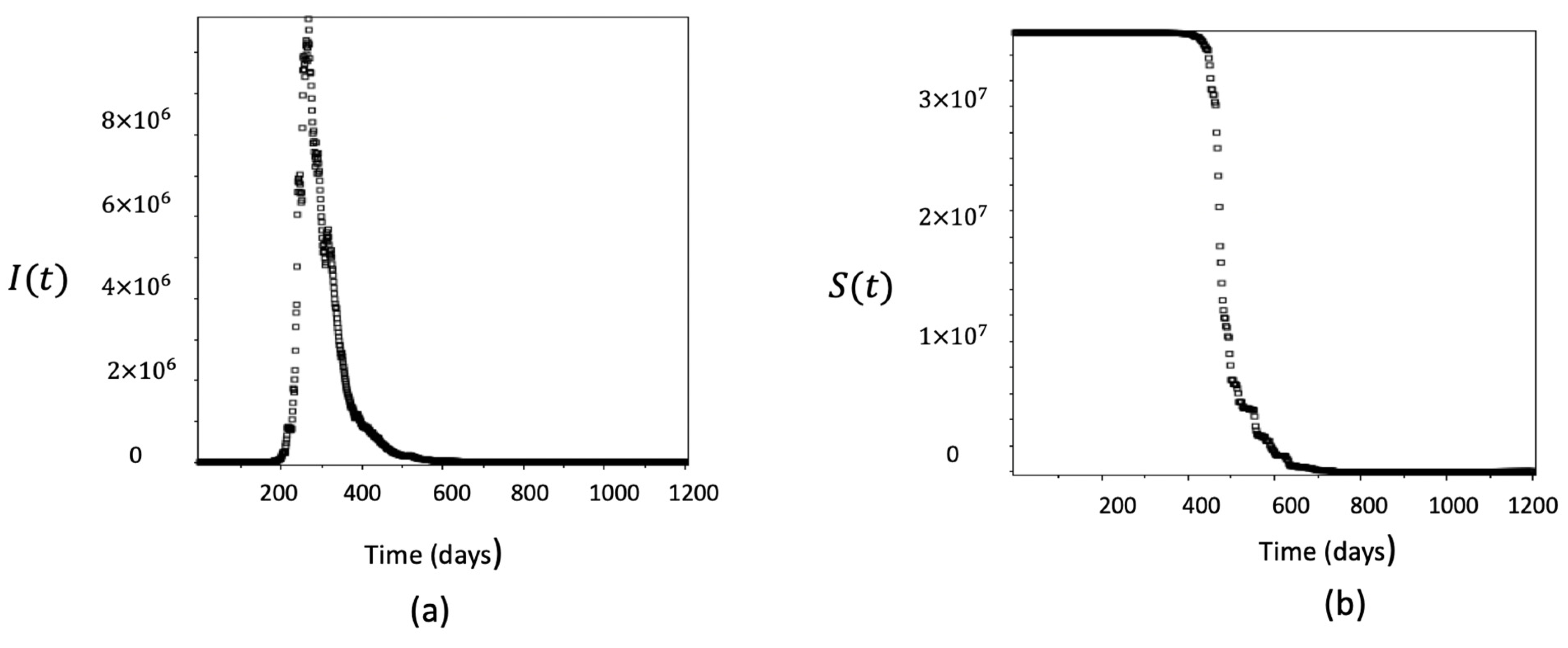
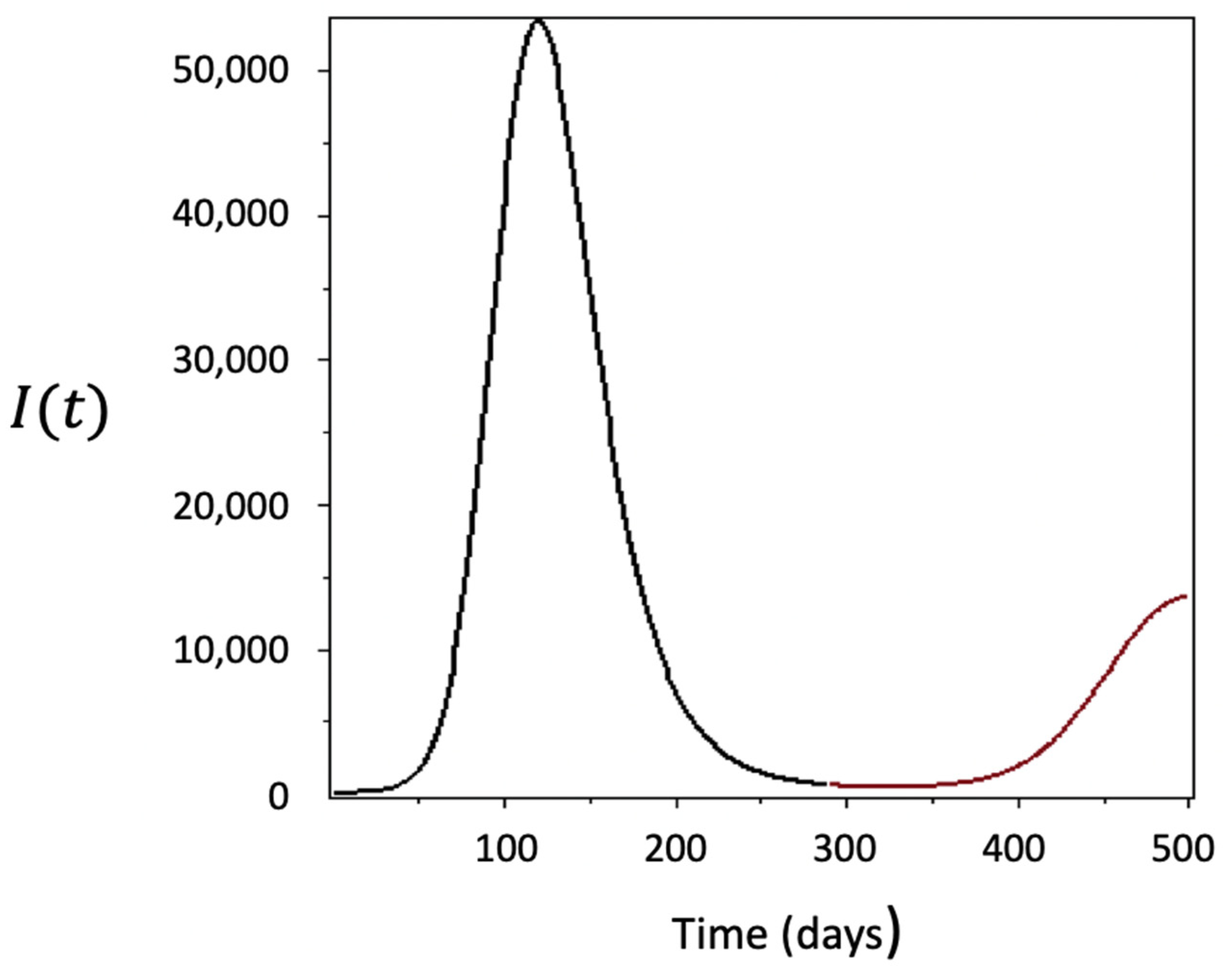
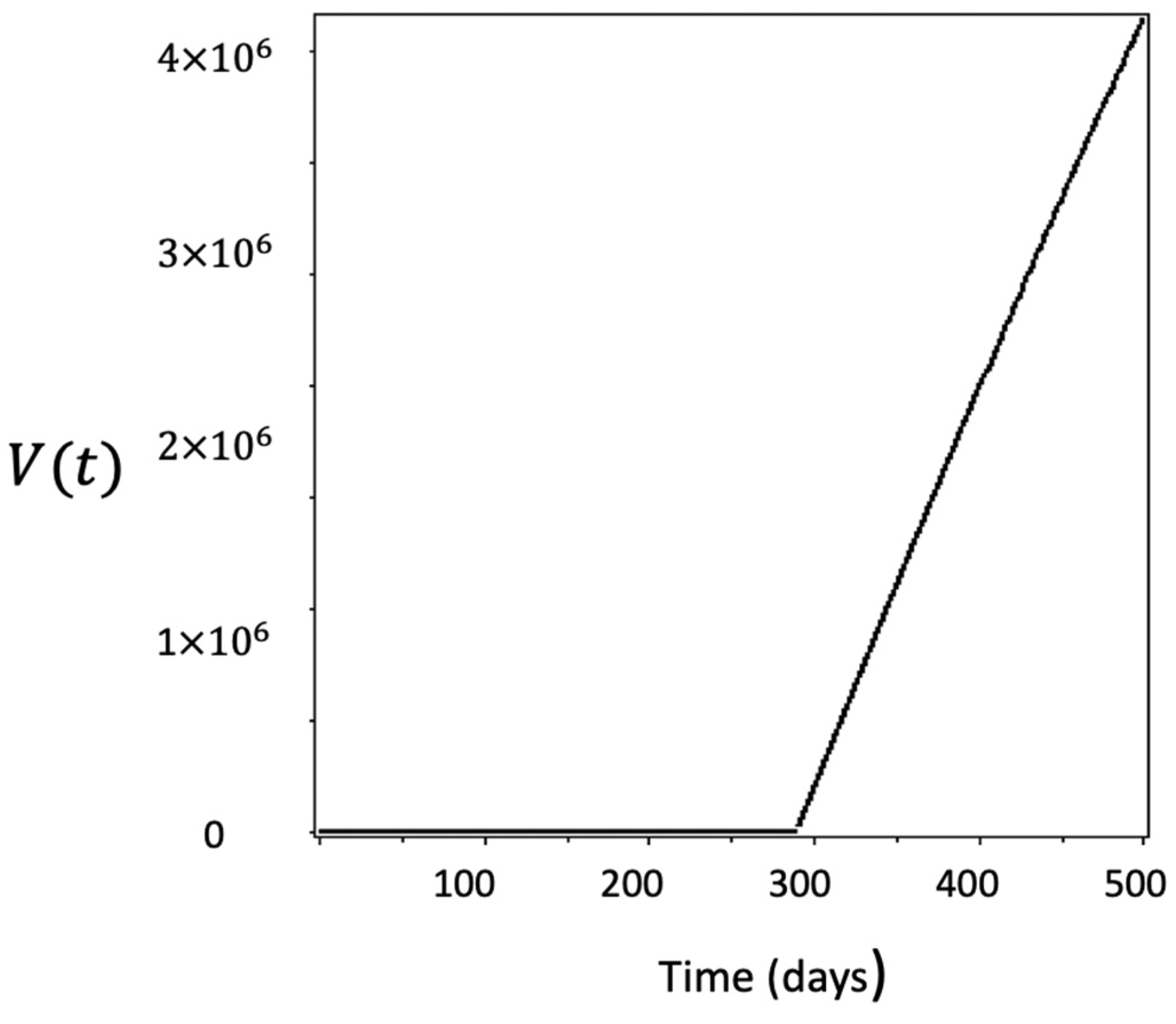

Disclaimer/Publisher’s Note: The statements, opinions and data contained in all publications are solely those of the individual author(s) and contributor(s) and not of MDPI and/or the editor(s). MDPI and/or the editor(s) disclaim responsibility for any injury to people or property resulting from any ideas, methods, instructions or products referred to in the content. |
© 2023 by the authors. Licensee MDPI, Basel, Switzerland. This article is an open access article distributed under the terms and conditions of the Creative Commons Attribution (CC BY) license (https://creativecommons.org/licenses/by/4.0/).
Share and Cite
Alshammari, F.S.; Akyildiz, F.T. Epidemic Waves in a Stochastic SIRVI Epidemic Model Incorporating the Ornstein–Uhlenbeck Process. Mathematics 2023, 11, 3876. https://doi.org/10.3390/math11183876
Alshammari FS, Akyildiz FT. Epidemic Waves in a Stochastic SIRVI Epidemic Model Incorporating the Ornstein–Uhlenbeck Process. Mathematics. 2023; 11(18):3876. https://doi.org/10.3390/math11183876
Chicago/Turabian StyleAlshammari, Fehaid Salem, and Fahir Talay Akyildiz. 2023. "Epidemic Waves in a Stochastic SIRVI Epidemic Model Incorporating the Ornstein–Uhlenbeck Process" Mathematics 11, no. 18: 3876. https://doi.org/10.3390/math11183876
APA StyleAlshammari, F. S., & Akyildiz, F. T. (2023). Epidemic Waves in a Stochastic SIRVI Epidemic Model Incorporating the Ornstein–Uhlenbeck Process. Mathematics, 11(18), 3876. https://doi.org/10.3390/math11183876




